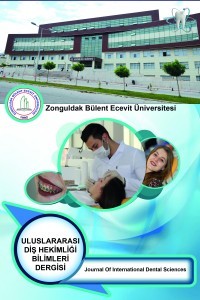FLUORİD JEL UYGULAMA SÜRESİNİN FİSSÜR ÖRTÜCÜLERİN YÜZEY PÜRÜZLÜLÜĞÜNE ETKİSİ
Amaç: Bu çalışmanın amacı, asidüle fosfat fluorid (APF) jelinin uygulama süresindeki farklılığın rezin esaslı fissür örtücülerin yüzey pürüzlülüğü üzerine etkisini incelemektir.
Gereç ve Yöntemler: Çalışmada rezin esaslı fissür örtücü (İ-Seal LC,İ-dental, Siauliai, Litvanya) materyali ile 160 adet disk hazırlandı. Örnekler 24 saat distile suda bekletildikten sonra bitirme ve cila işlemi diskler (Optidisk, Kerr, İsviçre) yardımıyla yapıldı. Örneklerin yüzeyinden profilometre cihazı ile başlangıç yüzey pürüzlülükleri ölçülerek Ra0 olarak kaydedildi. Ölçüm yapılan örnekler her grupta 40’ar disk olacak şekilde 4 gruba ayrıldı. Gruplardaki örnekler sırasıyla 1, 2, 3 ve 4 dakika % 1,23’lük APF jel (İonite, ABD) içerisinde bekletildi. Örneklerin yüzeyleri distile suyla yıkanarak, kurutuldu. Tüm örneklerin yüzey pürüzlülük değerleri ölçülerek Ra1 olarak kaydedildi. Veriler Shapiro Wilk testi, Kruskal Wallis ve Post Hoc Bonferroni testi ile analiz edilerek istatistiksel olarak değerlendirildi.
Bulgular: Çalışma gruplarında başlangıç ve bitiş pürüzlülük değerleri ortalamaları arasında istatistiksel olarak anlamlı bir fark bulundu (p
Anahtar Kelimeler:
Fluorid Jel, Fissür Örtücü, Yüzey Pürüzlülüğü.
EFFECT OF FLUORIDE GEL APPLICATIONS TIME ON THE SURFACE ROUGHNESS OF FISSURE SEALANTS
Objective: The aim of this study is to examine whether the difference in application time of Acidulated phosphate fluoride (APF) gel has an effect on the surface roughness of resin-based fissure sealants.
Materials and Method: In the study, 160 discs with resin-based fissure sealant (I-Seal LC, I-dental, Siauliai, Lithuania) material were first kept in distilled water for 24 hours, dried and polished with disc (Optidisk, Kerr, Switzerland). Initial surface roughness ( Ra0) was measured with a profilometer device. Afterwards, the samples were divided into 4 groups with 40 discs in each group. The samples in the groups were kept in 1.23% APF gel (Ionite, USA) for 1, 2, 3 and 4 minutes, respectively, washed with distilled water and dried. Again, the surface roughness values were measured and recorded as Ra1. The data were analyzed statistically with the Shapiro Wilk test, Kruskal Wallis and Post Hoc Bonferroni test.
Results: A statistically significant difference was found between the mean of the starting and finishing roughness values in the study groups (p
Keywords:
Fluoride Gel, Fıssure Sealants, Surface Roughness.,
- ISSN: 2149-8628
- Yayın Aralığı: Yılda 3 Sayı
- Yayıncı: Zonguldak Bülent Ecevit Üniversitesi
Sayıdaki Diğer Makaleler
ÇOCUK DİŞ HEKİMLİĞİNDE CAM İYONOMER SİMANLAR
Yusuf Bilge TEZCAN, Uğur ERGİN
ANTERİOR TEK DİŞ EKSİKLİĞİNDE Tİ-BASE ABUTMENT İLE ZİRKONYUM KRON RESTORASYONU: OLGU SUNUMU
Duygu Ece KESKİN, Feyza AKSU OLCAY, Ayşegül KÖROĞLU, Seda CENGİZ
BİYOSERAMİK ESASLI KÖK KANAL PATLARI
TÜRK ÇOCUK DİŞ HEKİMLERİNİN KANITA DAYALI DİŞ HEKİMLİĞİ UYGULAMALARINA DAİR BİLGİ VE TUTUMLARI
FLUORİD JEL UYGULAMA SÜRESİNİN FİSSÜR ÖRTÜCÜLERİN YÜZEY PÜRÜZLÜLÜĞÜNE ETKİSİ
Melek BELEVCİKLİ, Gamze KILIÇ, Edanur ÇAKIR
PROTETİK DİŞ HEKİMLİĞİNDE NANOPARTİKÜLLER
Dalndushe ABDULAI, Ayşegül KÖROĞLU, Seda CENGİZ
DİŞ HEKİMLERİNİN STRESLE MÜCADELESİNDE EVCİL HAYVANLARIN ROLÜ
